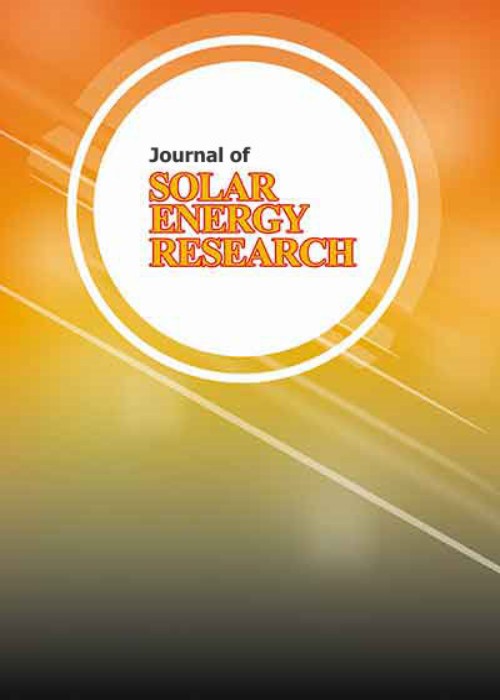فهرست مطالب
Journal of Solar Energy Research
Volume:1 Issue: 1, Summer 2016
- تاریخ انتشار: 1395/04/11
- تعداد عناوین: 6
-
-
Pages 13-22The paper presents study the factors that can improve the performance of an activated carbon/methanol intermittent solar adsorption icemarker. That uses an adsorption tube collector for cooling, in which solar energy can be directly absorbed. Effect of some important parameters, such as amount 8of methanol, condenser temperat., initial and peak collector temperat., on the system performances were investigated. The amount of activated carbon is fixed and is equal to (4 kg) for all the experiments that have been performed. Several quantities of Methanol were tested (650 g, 750g, 900g) to get the best system performance. The experimental test rig of present work was designed to produce 2 kg of ice by using Activated Carbon in a concentration of 0.28 kg Methanol/kg Activated Carbon. The shape of the flat plate type adsorber/collector was parallelogram with dimensions (110 cm× 67 cm×8 cm). The results show that the coefficient of performance of the unit decreases with increase the condenser and evaporator temperat.. The new in this paper that the maximum average of COP was 0.49 but the minimum was 0.4 that agree with literat. experiments in this field.Keywords: Adsorption, Refrigeration, Active carbon, Methanol
-
Pages 23-33A theoretical investigation is conducted for a novel renewable energy based multigeneration system producing hydrogen by means of a proton exchange membrane (PEM) electrolyzer as well as several commodities, namely power, drying, cooling and hot water. Engineering Equation Solver (EES) software is applied to model the PEM electrolyzer and multigeneration system. Thermodynamic, cost and environmental impact evaluations are included for hydrogen produced by considering the major design parameters. Outcomes indicate that the turbine inlet press. increases the hydrogen exergy efficiency of the system within 56% and decreases its environmental impact by about 3.8 % whereas it has a negative effect on the hydrogen cost produced. Moreover, the current density and temperat. of the electrolyzer affect the cost and environmental impact of hydrogen negatively.Keywords: Solar Energy, Hydrogen production, exergoeconomic, exergoenvironment
-
Pages 35-43Solar energy application as an important element of energy sustainability can be an important issue considering Iranian Resistance Economy policy. Compound Sustainable Energy launching Framework (CSEL) already has been developed in order to facilitate the deployment of sustainability initiatives and eliminate existing barriers in the industrial sector. This paper presents an application of Soft Systems Methodology (SSM) in applying this framework in Iranian Household Sector specially to facilitate solar energy application in this sector. The application of SSM and CSEL framework is discussed in this paper and it is proved that SSM method links CSEL framework to the solar energy application in the Iranian architect environment. The CSEL multi-methodology framework aims not only eliminating energy sustainability barriers but also an efficient assignment of capital investment on such initiatives.Keywords: Soft systems methodology, Multi- Methodology, Solar Energy, CSEL Framework
-
Pages 45-51In this paper, a water cooled thermal photovoltaic (PV/T) system has been optimized by using genetics algorithm in MATLAB software. Electrical and thermal efficiencies have been defined as objective functions based on energy and exergy considerations. As a result of optimization, achieved value for each of independent variables has been optimized. Similarly, a Pareto diagram for optimum range of decision variables is illustrated for multi objective function.Keywords: water cooled thermal photovoltaic, plate, spiral tube structure, Optimization, genetics algorithm
-
Pages 53-58In this paper, a new quadruple generation plant with biomass and solar energy as input and four useful outputs, such as hydrogen, heating, power, and hot water is analysed from thermodynamic point of view. The proposed system includes parabolic solar collectors (PTC), biomass burners, the Rankine cycle (SRC), domestic water heater (DWH) and proton exchange membrane (PEM). The results showed that the energy efficiency of the system is 58.24% while the exergy efficiency is 51.68% and the main sources of exergy destructions are biomass burner, solar collectors, and electrolyzer.Keywords: Solar Energy, exergy, Efficiency, Biomass, Hydrogen production
-
Pages 59-62
Daylight is one of the primary factors of thermal comfort. In warm regions, this factor is the cause of excessive heat absorption and energy loss due to further need for cooling solutions. Therefore, design of exterior facade as a sun-exposed structural envelope can play an effective role in indoors heat absorption. Natural structures use several solutions for optimal control and management of daylight. Mimicking these solutions can prove effective in achieving energy optimization and thermal comfort conditions. This paper aims to provide such solution by assessing and mimicking the structure of cactus and designing an efficient exterior accordingly for residential buildings located in hot climates. The results show that presence of suitably sized indentations and protrusions in the walls reduce heat absorption and energy consumption.
Keywords: Solar passive design, Solar Façade, Biomimicry, Cactus, Energy Efficiency


